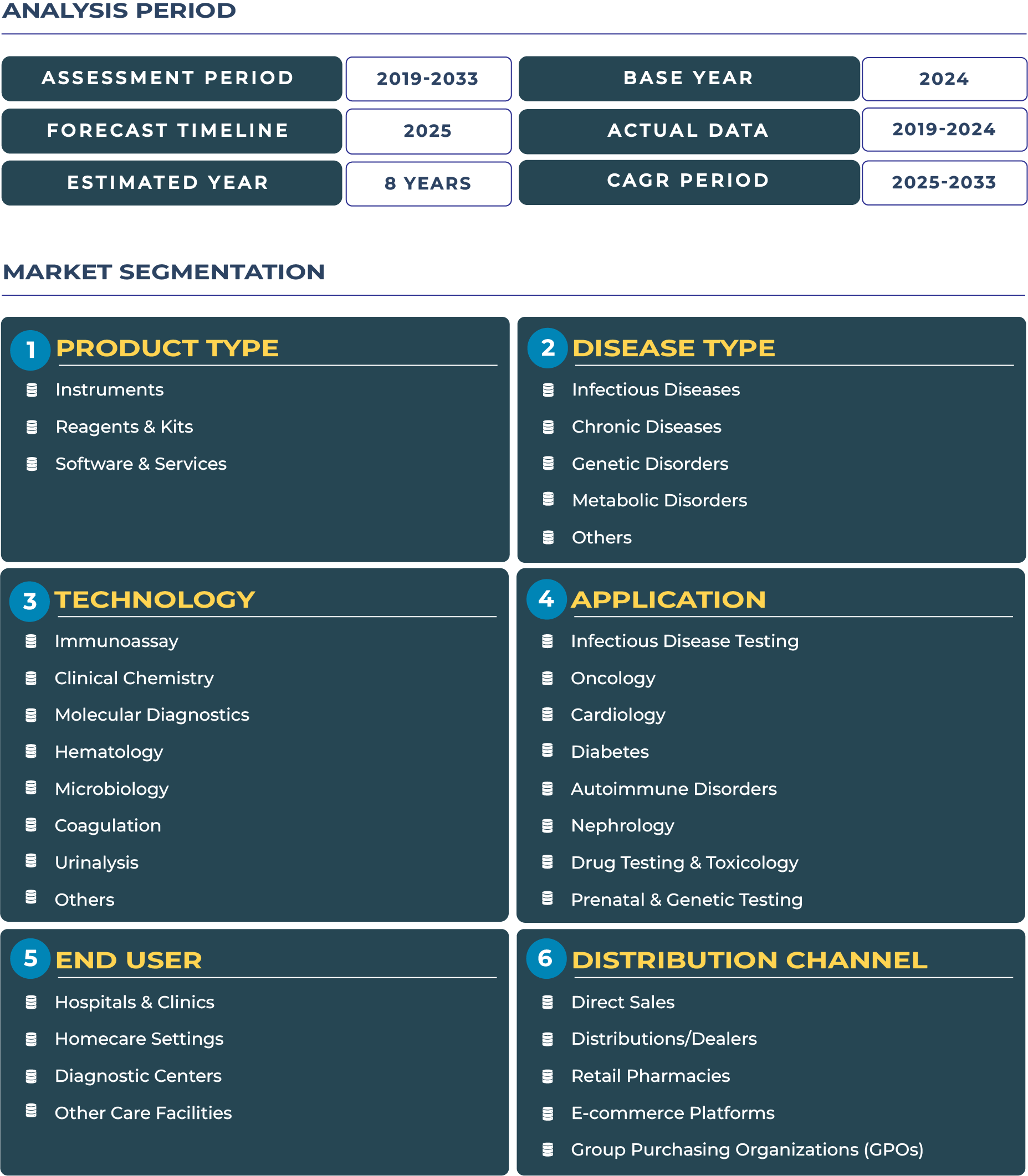Argentina’s Healthcare Reforms Balancing Demand Challenges: A Volatile Yet Reform-Driven In-vitro Diagnostic Market
Argentina’s healthcare system stands at a critical juncture where policy reforms are being implemented to balance demand pressures and accessibility gaps amid macroeconomic instability. The country’s in-vitro diagnostic (IVD) market reflects this transformation, navigating through inflationary pressures and political uncertainties while embracing modernization in healthcare infrastructure. With healthcare reforms such as the expansion of the Ministry of Health of Argentina’s Universal Health Coverage framework and the digitalization of laboratory services, Argentina IVD landscape is gradually stabilizing.
As per current estimations, the Argentina In-vitro Diagnostic Market is valued at USD 738.4 million in 2025 and is expected to reach USD 869.6 million by 2033. Despite the macroeconomic challenges, reform-driven policies, growing private healthcare networks, and adoption of digital diagnostic tools are collectively supporting market resilience. Rising demand for molecular diagnostics, immunoassays, and point-of-care testing within urban hospitals is further enhancing diagnostic accuracy and reducing dependence on centralized laboratories.
Strong Clinician Base and Private Hospital Clusters Fueling IVD Market Growth
Argentina’s healthcare infrastructure benefits from a robust base of trained clinicians and expanding private hospital networks that are accelerating the uptake of advanced diagnostic technologies. Private groups such as Hospital Italiano de Buenos Aires are leading initiatives to integrate automated instruments, digital pathology, and data-driven diagnostics within their testing ecosystem. This institutional modernization enhances the use of reagent-based testing and software-enabled diagnostics, particularly for infectious and chronic disease management.
Furthermore, the growing presence of private laboratories across metropolitan areas like Buenos Aires, Córdoba, and Rosario is contributing to improved accessibility of diagnostic testing. The post-pandemic shift towards preventive diagnostics has also spurred demand for IVD kits in both hospital and ambulatory settings. This ongoing evolution is being supported by local production initiatives under Argentina’s industrial promotion schemes, which aim to reduce import dependency and stabilize reagent supply chains.
Macroeconomic Instability and Reimbursement Unpredictability Constraining Growth Momentum
While structural reforms have enhanced market resilience, the Argentina In-vitro Diagnostic industry continues to face challenges arising from fiscal instability and reimbursement unpredictability. Currency depreciation and strict import controls hinder the flow of reagents, instruments, and critical components required for diagnostic operations. Local distributors often struggle to maintain consistent supply due to delayed foreign exchange approvals and fluctuating material costs.
Additionally, reimbursement models for diagnostic tests remain fragmented, with varying policies between public and private insurers. This lack of standardization discourages small and mid-tier diagnostic providers from adopting high-cost molecular systems. The unpredictability of healthcare financing further restricts investment in advanced automation and laboratory information systems. Despite these constraints, adaptive business models and government dialogues on healthcare affordability are gradually helping stabilize the ecosystem.
Private Clinics Expansion and Medical Tourism Boosting Regional Diagnostic Demand
Argentina’s urban centers are witnessing an expansion of private clinics equipped with modern diagnostic infrastructure, reflecting an evolving patient preference for personalized and efficient healthcare services. Cities such as Buenos Aires and Mendoza are emerging as regional medical tourism hubs, attracting patients from neighboring Latin American countries seeking cost-effective diagnostic services. This trend has accelerated the adoption of rapid and molecular testing technologies within private laboratories.
Moreover, collaborations between healthcare institutions and diagnostic suppliers have led to innovative supplier-financing models, allowing clinics to acquire advanced IVD equipment with deferred payment options. These mechanisms have significantly mitigated the impact of economic volatility while ensuring continuous diagnostic operations. The integration of data analytics and remote diagnostic monitoring also aligns with Argentina’s broader national digital health roadmap, promoting interoperability and patient data management efficiency.
Local Distributor Financing and Value-based Offerings Emerging as Key Opportunities
The evolving Argentina In-vitro Diagnostic ecosystem is presenting unique opportunities for suppliers and investors through localized financing solutions and value-based service offerings. Local distributor financing initiatives are enabling steady procurement cycles, especially among independent laboratories and diagnostic startups. This model ensures liquidity during economic downturns and sustains market competitiveness.
In addition, growing demand for affordable testing kits in rural provinces has created opportunities for domestic manufacturers to expand production capacity. Strategic partnerships between distributors and private clinics are promoting bundled reagent and service contracts, ensuring stable revenue streams. As government policies continue to emphasize import substitution and local innovation, the value-oriented approach in Argentina’s diagnostic sector will remain pivotal for long-term sustainability.
Strategic Moves by Key Players Defining Argentina’s Competitive IVD Landscape
The competitive landscape of Argentina’s in-vitro diagnostic sector is characterized by the active participation of both international and domestic players. Multinational corporations such as Roche, Abbott, and Siemens Healthineers continue to maintain a strong presence through strategic partnerships with local distributors. Their focus on expanding molecular testing platforms and digital integration has reinforced Argentina’s position as a diagnostics innovation hub in South America.
Local players are also gaining traction by customizing reagent formulations and software solutions to suit regional healthcare needs. For instance, new collaborations between domestic suppliers and public hospitals have emerged to enhance testing accuracy and reduce costs. Companies are increasingly adopting flexible pricing structures and distributor-based financing models to navigate inflationary cycles. These strategic adjustments ensure that diagnostic service providers can maintain testing capacity even during macroeconomic downturns, preserving continuity of care.







